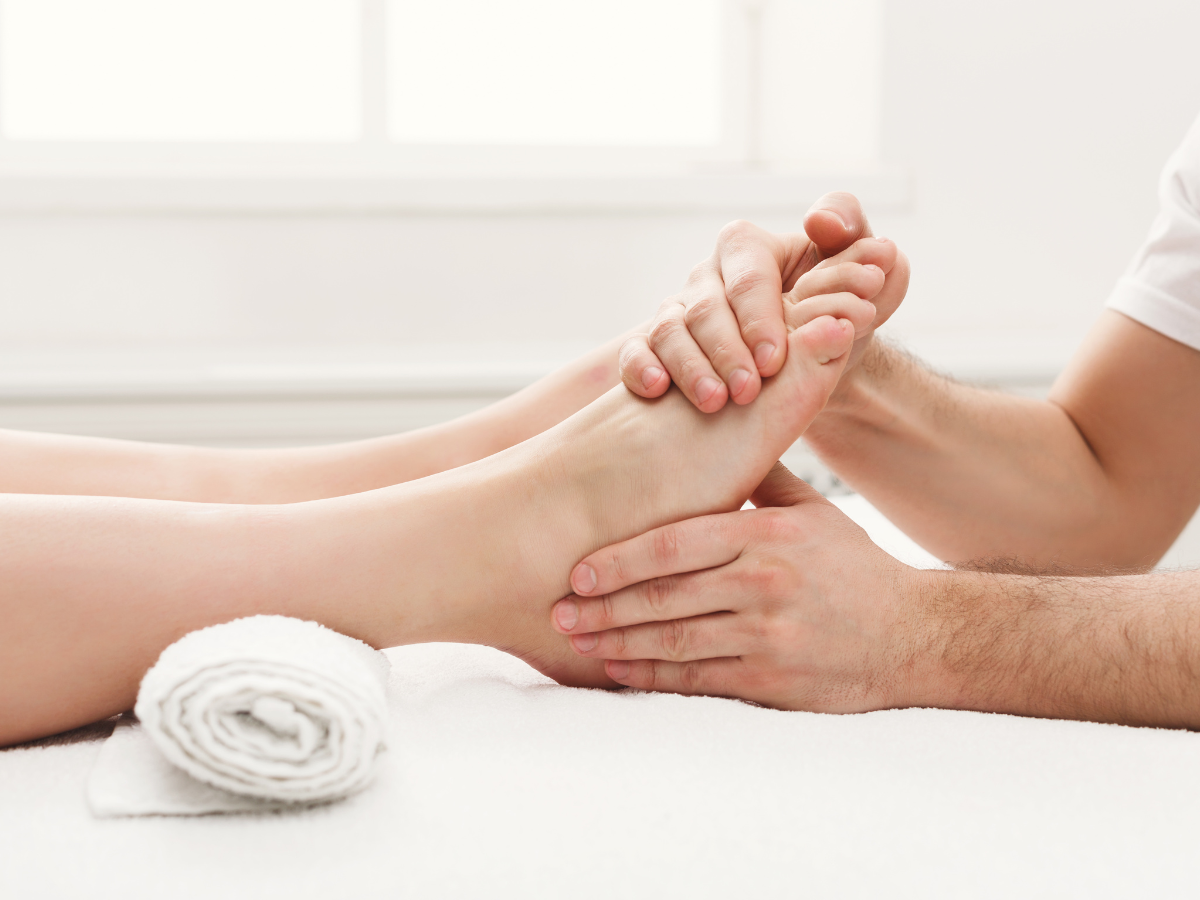Acupressure Massage Therapy Services
Overland Park
Unlocking the Power of Acupressure for Holistic Healing in Chiropractic Care
Acupressure is an ancient healing art that has been practiced for thousands of years in traditional Chinese medicine. It involves the application of pressure to specific points on the body to promote the flow of energy, relieve pain and tension, and improve overall health and well-being. As a complementary therapy to chiropractic care, acupressure can help to enhance the benefits of spinal adjustments and support the body’s natural healing processes. In this post, we’ll explore the principles of acupressure, its benefits, and how it can be incorporated into a comprehensive chiropractic care plan.

What is Acupressure?
Acupressure is a form of traditional Chinese medicine that involves the application of pressure to specific points on the body to improve the flow of energy and promote healing. It is based on the concept of Qi (pronounced “chee”), which is believed to be the life force or vital energy that flows through the body. The practice of acupressure involves stimulating certain points along the energy pathways, known as meridians, to unblock any obstructions and restore the balance of Qi.
Acupressure is a non-invasive therapy that uses the hands, fingers, or tools to apply pressure to specific points on the body. The pressure can be applied using various techniques, including pressing, massaging, or tapping the points. The pressure can range from gentle to firm, depending on the individual’s needs and the condition being treated.
Acupressure is considered safe for most people and has few side effects. It can be used in combination with other therapies, such as chiropractic care, massage therapy, and acupuncture, to enhance their effects. However, it is important to seek the advice of a qualified practitioner before beginning any new therapy, especially if you have a medical condition or are taking medication.
How does it work?

Acupressure works by applying pressure to specific points on the body, known as acupoints, to stimulate the flow of energy along the body’s meridians. The meridians are believed to be channels through which the body’s vital energy, or Qi, flows. When the flow of Qi is disrupted, it can lead to physical, emotional, or mental health problems.
By applying pressure to acupoints, acupressure is thought to help release any blockages in the flow of Qi, which can help restore the balance of energy in the body. This can help to relieve symptoms, reduce pain and tension, and promote the body’s natural healing processes.
The exact mechanisms by which acupressure works are not fully understood, but it is believed that the stimulation of acupoints triggers the release of endorphins, the body’s natural painkillers. This can help to relieve pain and improve the overall sense of well-being.
Additionally, acupressure may also stimulate the nervous system and promote circulation, which can help to bring oxygen and nutrients to the affected area, speed up the healing process, and relieve muscle tension.
In summary, acupressure works by using the hands, fingers, or tools to apply pressure to specific acupoints, which can help to stimulate the flow of energy along the meridians, relieve pain and tension, and promote the body’s natural healing processes.
The procedure
The procedure for acupressure typically involves the following steps:
- Assessment: Before beginning the acupressure session, the practitioner will ask about your medical history, current symptoms, and the areas of the body that are causing discomfort.
- Finding the acupoints: The practitioner will then identify the acupoints that correspond to your specific health concerns. These points are located along the body’s meridians, and the practitioner will determine which points need to be stimulated based on your symptoms and the pattern of energy imbalances in your body
- Preparation: You will lie down or sit comfortably, and the practitioner may ask you to remove any tight clothing so that they can access the necessary acupoints.
- Applying pressure: The practitioner will then use their fingers, hands, or a tool to apply pressure to the acupoints. The pressure can range from gentle to firm, depending on the individual’s needs and the condition being treated. The pressure is usually held for several seconds, and the practitioner may repeat the process several times.
- Duration of session: A typical acupressure session can last anywhere from 30 minutes to an hour. The number of sessions needed will depend on the individual’s health condition and the severity of their symptoms.
- Aftercare: After the session, it is recommended that you rest for a few minutes and drink plenty of water to help flush out any toxins that may have been released during the treatment.
Acupressure is a safe and non-invasive therapy, and most people find it to be relaxing and enjoyable. However, it is important to seek the advice of a qualified practitioner before beginning any new therapy, especially if you have a medical condition or are taking medication.

The procedure
The procedure for acupressure typically involves the following steps:
- Assessment: Before beginning the acupressure session, the practitioner will ask about your medical history, current symptoms, and the areas of the body that are causing discomfort.
- Finding the acupoints: The practitioner will then identify the acupoints that correspond to your specific health concerns. These points are located along the body’s meridians, and the practitioner will determine which points need to be stimulated based on your symptoms and the pattern of energy imbalances in your body
- Preparation: You will lie down or sit comfortably, and the practitioner may ask you to remove any tight clothing so that they can access the necessary acupoints.
- Applying pressure: The practitioner will then use their fingers, hands, or a tool to apply pressure to the acupoints. The pressure can range from gentle to firm, depending on the individual’s needs and the condition being treated. The pressure is usually held for several seconds, and the practitioner may repeat the process several times.
- Duration of session: A typical acupressure session can last anywhere from 30 minutes to an hour. The number of sessions needed will depend on the individual’s health condition and the severity of their symptoms.
- Aftercare: After the session, it is recommended that you rest for a few minutes and drink plenty of water to help flush out any toxins that may have been released during the treatment.
Acupressure is a safe and non-invasive therapy, and most people find it to be relaxing and enjoyable. However, it is important to seek the advice of a qualified practitioner before beginning any new therapy, especially if you have a medical condition or are taking medication.


Benefits
Acupressure is a versatile therapy that offers numerous benefits, including:
- Pain relief: Acupressure can help to relieve pain, including headaches, menstrual cramps, back pain, and arthritis. By stimulating the flow of energy along the body’s meridians, it can help to reduce muscle tension, relieve pain, and promote healing.
- Stress and anxiety reduction: Acupressure can help to reduce stress and anxiety by calming the nervous system and promoting relaxation. The pressure applied to acupoints can help to release endorphins, the body’s natural painkillers, which can improve the overall sense of well-being.
- Improved sleep: Acupressure can help to improve sleep by reducing stress and promoting relaxation. It can also help to relieve symptoms such as insomnia and sleep apnea.
- Boosted immune system: Acupressure can help to boost the immune system by improving circulation, which can bring oxygen and nutrients to the cells, and by promoting relaxation, which can help to reduce stress and improve overall health.
- Digestive health: Acupressure can help to improve digestive health by relieving symptoms such as nausea, constipation, and bloating.
- Relief of allergies: Acupressure can help to relieve symptoms of allergies, such as sneezing, runny nose, and itching, by improving circulation and promoting the body’s natural healing processes.
- Menstrual pain relief: Acupressure can help to relieve menstrual cramps and other menstrual-related discomforts.
- Overall well-being: Acupressure can promote overall well-being by reducing stress, relieving pain, and improving the flow of energy in the body.
It is important to note that while acupressure is a safe and effective therapy, it is not a substitute for conventional medical treatment. If you have a serious medical condition, it is important to seek the advice of a doctor or other qualified healthcare provider before beginning any new therapy.

Benefits
Acupressure is a versatile therapy that offers numerous benefits, including:
- Pain relief: Acupressure can help to relieve pain, including headaches, menstrual cramps, back pain, and arthritis. By stimulating the flow of energy along the body’s meridians, it can help to reduce muscle tension, relieve pain, and promote healing.
- Stress and anxiety reduction: Acupressure can help to reduce stress and anxiety by calming the nervous system and promoting relaxation. The pressure applied to acupoints can help to release endorphins, the body’s natural painkillers, which can improve the overall sense of well-being.
- Improved sleep: Acupressure can help to improve sleep by reducing stress and promoting relaxation. It can also help to relieve symptoms such as insomnia and sleep apnea.
- Boosted immune system: Acupressure can help to boost the immune system by improving circulation, which can bring oxygen and nutrients to the cells, and by promoting relaxation, which can help to reduce stress and improve overall health.
- Digestive health: Acupressure can help to improve digestive health by relieving symptoms such as nausea, constipation, and bloating.
- Relief of allergies: Acupressure can help to relieve symptoms of allergies, such as sneezing, runny nose, and itching, by improving circulation and promoting the body’s natural healing processes.
- Menstrual pain relief: Acupressure can help to relieve menstrual cramps and other menstrual-related discomforts.
- Overall well-being: Acupressure can promote overall well-being by reducing stress, relieving pain, and improving the flow of energy in the body.
It is important to note that while acupressure is a safe and effective therapy, it is not a substitute for conventional medical treatment. If you have a serious medical condition, it is important to seek the advice of a doctor or other qualified healthcare provider before beginning any new therapy.
Research and Clinical Evidence
Acupressure has been practiced for thousands of years and has a rich history of use in traditional Chinese medicine. Despite its long history, there is limited research on the efficacy of acupressure, and much of the available research has been limited by small sample sizes, poor study design, and the lack of a control group.
However, some recent studies have shown promising results for the use of acupressure in various conditions. For example:
- Pain relief: A number of studies have found that acupressure can be effective for relieving pain, including headaches, menstrual cramps, and lower back pain.
- Stress and anxiety: Research has shown that acupressure can help to reduce stress and anxiety, and may be as effective as other therapies such as massage and counseling.
- Improved sleep: Several studies have found that acupressure can help to improve sleep, including reducing symptoms of insomnia and sleep apnea.
- Nausea and vomiting: A number of studies have found that acupressure can be effective for relieving symptoms of nausea and vomiting, including in patients undergoing chemotherapy or surgery.
- Labor and delivery: Acupressure has been shown to be effective in reducing pain during labor and delivery, and may also help to shorten the duration of labor.
While the available research on acupressure is limited, the results of these studies are promising and suggest that acupressure may have clinical benefits for a variety of conditions. However, more research is needed to fully understand the efficacy of acupressure and to determine the best practices for its use.
It is important to keep in mind that acupressure should not be used as a substitute for conventional medical treatment. If you are experiencing a serious medical condition, it is important to seek the advice of a doctor or other qualified healthcare provider before beginning any new therapy.
Final Thoughts
In conclusion, acupressure is an ancient form of therapy that has been used for thousands of years in traditional Chinese medicine. It involves the application of pressure to specific points on the body, known as acupoints, in order to improve the flow of energy and promote healing. While there is limited research on the efficacy of acupressure, the available studies suggest that it may be effective for a variety of conditions, including pain relief, stress and anxiety reduction, improved sleep, and nausea and vomiting.
Despite its potential benefits, acupressure should not be used as a substitute for conventional medical treatment. If you are experiencing a serious medical condition, it is important to seek the advice of a doctor or other qualified healthcare provider before beginning any new therapy.
Acupressure is a simple and non-invasive form of therapy that can be performed easily and safely in the comfort of your own home. Whether you are looking to relieve pain, reduce stress, or improve your overall sense of well-being, acupressure is a technique that is well worth exploring.
At Integrative Chiropractic in Overland Park, we believe that our patients should always have access to quality chiropractic care. We offer a variety of services including chiropractic treatment, massage therapy, and physical therapy. And our staff is here to help you find the best option for your specific needs. If you’re looking for a chiropractor in Overland Park who can help improve your health, come see us at Integrative Chiropractic.
Testimonials
Happy Patients
“Really appreciated the time spent listening to issues and understanding that everything is connected. Saw great improvement for my back stiffness on the very first visit.”
Through online scheduler
“I am in shock and awe….. after dealing with chronic hip, shoulder & neck pain for a year, Dr. Ladd was able to find the problem and solution immediately. I felt so much better after the first visit and now I see a light at the end of the tunnel!”
Through online scheduler
“Couldn’t be more satisfied, Dr. Carston is just FANTASTIC!! Having been to several well known Spine, Hip and Knee Specialists in the past 2 years I the Overland Park and Leawood area, and not having had any reasonable diagnostics and treatment for my problem, to have found Dr. Carlston has been a blessing. I definitely would recommend him eyes closed!”
Through online scheduler
Ready for pain relief?
If you have pain and have been everywhere else without relief, schedule a visit to see what’s been missing.
